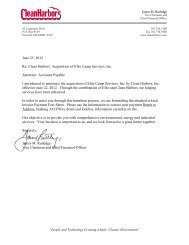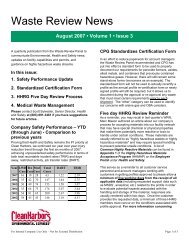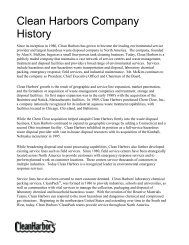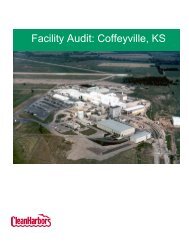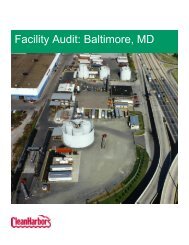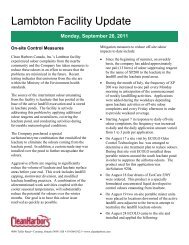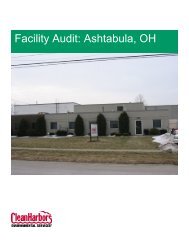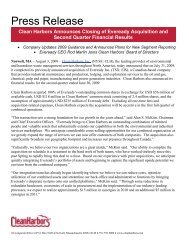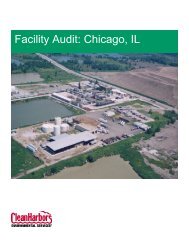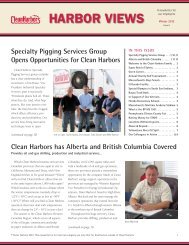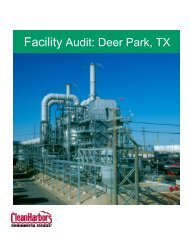Facility Audit: Kimball, NE - Clean Harbors
Facility Audit: Kimball, NE - Clean Harbors
Facility Audit: Kimball, NE - Clean Harbors
You also want an ePaper? Increase the reach of your titles
YUMPU automatically turns print PDFs into web optimized ePapers that Google loves.
Table of Contents1.0 General Company Information ..................................................................................................................... 1Introduction............................................................................................................................................. 1Network of Services................................................................................................................................12.0 <strong>Facility</strong> Information ...................................................................................................................................... 3<strong>Facility</strong> Overview.................................................................................................................................... 3Heath & Safety........................................................................................................................................ 3<strong>Facility</strong> Site Plan..................................................................................................................................... 5<strong>Facility</strong> History ....................................................................................................................................... 6Site Characterization............................................................................................................................... 6Security ................................................................................................................................................... 6Directions to <strong>Facility</strong>............................................................................................................................... 73.0 Operating Licenses and Permits.................................................................................................................... 8Permit Summary ..................................................................................................................................... 8Principal Operating Licenses/Permits..................................................................................................... 84.0 Waste Acceptance....................................................................................................................................... 10Waste Analysis...................................................................................................................................... 10On-Site Analysis/Acceptance ............................................................................................................... 135.0 Waste Storage ............................................................................................................................................. 146.0 Process Description..................................................................................................................................... 167.0 Closure Plan................................................................................................................................................ 188.0 Insurance..................................................................................................................................................... 189.0 Financial Information.................................................................................................................................. 2010.0 Appendix................................................................................................................................................... 20
1.0 General Company InformationIntroduction<strong>Clean</strong> <strong>Harbors</strong> is a publicly traded company who maintains a vast network of service centers andwaste management, treatment and disposal facilities, providing a broad range of environmentalservices. Services include hazardous and non-hazardous waste transportation and disposal,laboratory chemical packing, emergency response, and field services and industrial maintenance.Since its inception in 1980, <strong>Clean</strong> <strong>Harbors</strong> has grown to become the leading provider ofenvironmental services in the country in North America and its locations span the United Statesand Canada, and include locations in Mexico and Puerto Rico.Network of ServicesStrategically located across North America, <strong>Clean</strong> <strong>Harbors</strong>’ service centers are the primaryinterface with customers and the focal point for providing waste management activities,laboratory chemical packing services, and emergency response, field services and industrialmaintenance. From the service center Site Service crews and equipment are dispatched toperform various planned work on customers’ sites, as well as emergency response. <strong>Clean</strong>Packteams are also based at the service centers and provide customers with laboratory chemicalpacking services.Technical Services – Technical Services provides the pick up and transportation ofcontainerized and bulk wastes, as well as the categorizing, packaging and removal of laboratorychemicals for disposal. Through a network of Technical Service Centers, trucks are typicallydispatched on predetermined schedules to pick up waste from customer locations for delivery toa <strong>Clean</strong> <strong>Harbors</strong> Transfer, Storage and Disposal <strong>Facility</strong>. The Technical Service Centers alsodispatch <strong>Clean</strong>Pack ® chemists who go to customer locations to categorize, package and removevarious sized laboratory chemicals for disposal.Transportation & Disposal - <strong>Clean</strong> <strong>Harbors</strong>’ network of company owned waste treatment,storage and disposal facilities are located across North America and offer a broad range ofdisposal, recycling and treatment technologies for hazardous and non-hazardous materials.Technologies include:• Incineration• Water Treatment• Landfill• Recycling and Reuse• Fuel Blending• Lab Chemical Disposal• Used Oil and OilProducts Recycling• PCB Disposal• Explosives Management1
All of our disposal facilities uphold rigorous quality assurance programs to meet the higheststandards of both internal and external audits.Waste streams handled by <strong>Clean</strong> <strong>Harbors</strong> can be in any form from gas to liquids, solids andsludge. <strong>Clean</strong> <strong>Harbors</strong> can dispose of virtually any type of waste, hazardous or non-hazardousfrom exotic water reactive wastes to typical paint or oil wastes.Our transportation services handle everything from small one-time shipments to multiple largeshipments, and include drum, bulk and rail capabilities. Once you place your order and beforethe picked up is even made, <strong>Clean</strong> <strong>Harbors</strong> begins the process of managing your waste. Yourorder enters our Logistics center where your waste is designated for disposal via the least costrouting. Company owned and operated trucks are assigned based on the most efficient route oron pre-established schedules. Satellite tracking and communications allows trucks to bedispatched on the fly from anywhere in the country. The disposal facility is determined based onthe most appropriate, yet lowest cost disposal method.Furthermore, plant inventories are centrally monitored real-time and our facilities know inadvance and begin load planning for efficient processing of incoming waste. All this upfrontwork is managed centrally and electronically to provide the most cost effective and efficienthandling of orders, and waste transportation and disposal, in the industry.<strong>Clean</strong>Pack® Laboratory Chemical Packing Services - <strong>Clean</strong> <strong>Harbors</strong>’ staff of professionallytrained <strong>Clean</strong>Pack chemists work on customers’ sites to collect, label and package unwantedlaboratory quantities of chemicals and wastes for disposal in compliance with local, state, andfederal regulations. Additionally, <strong>Clean</strong>Pack teams provide reactive material handling servicesand cylinder and compressed gas management for the proper handling and disposal of highlyreactive and dangerous chemicals, laboratory move services. The teams also manage the movingof entire laboratories, as well as assist in facility closures. Our household hazardous wastecollection program offers a cost effective and safe manner for States, Provinces, Cities andTowns to keep their resident’s free of unwanted old and obsolete pesticides, paints, fertilizersand other potentially harmful materials.Site Services – The Site Services is responsible for providing trained, skilled labor and specialtyequipment to perform various services on a customer’s site or other location. Field Servicecrews and equipment are dispatched on a planned or emergency basis to manage routine cleaningin hazardous environments or emergencies such as a chemical or oil spill clean up. IndustrialService crews focus on industrial cleaning and maintenance projects that typically require fastturnaround, as well as large-scale cleaning project requiring specialty onsite processingequipment.Field Services - Working in hazardous and non-hazardous environments, Field Service crewsand equipment are dispatched on a planned or emergency basis to perform services such asemergency response, vacuum services, tank cleaning, site decontamination, product recovery andtransfer, demolition services, marine services, used oil and oil products recycling, PCBmanagement and disposal, and remediation and environmental construction.Industrial Services - Industrial Services teams use advanced industrial cleaning technologiesincluding sodium bicarbonate blasting, hydroblasting, and steam-cleaning along with vacuum2
services to accomplish fast turnaround during time-critical plant shutdowns. The teams alsoperform onsite material processing services, and dewatering and pressing, and containermanagement services.2.0 <strong>Facility</strong> Information<strong>Facility</strong> Overview<strong>Clean</strong> <strong>Harbors</strong> Environmental Services, Inc., a subsidiary of <strong>Clean</strong> <strong>Harbors</strong>, Inc. headquarteredin Norwell, Massachusetts, owns and operates a hazardous waste storage, treatment and disposalfacility located in <strong>Kimball</strong>, Nebraska. The <strong>Kimball</strong> facility is a RCRA-permitted, commercialfacility for treatment, storage and disposal of hazardous waste. The site includes a fluidized-bedincinerator for thermal destruction of hazardous waste, a monofill for disposal of delisted ash,and an analytical laboratory for waste analysis. The Nebraska Department of EnvironmentalQuality (NDEQ) continuously monitors operations and stack gas emissions via computer link.The advanced design of the <strong>Kimball</strong> <strong>Facility</strong> ensures maximum destruction efficiency of waste.The residual ash from the incinerator is "delisted," meaning it no longer is regulated as ahazardous waste under RCRA. No other commercial incineration facility in the United States iscurrently authorized to delist ash. Delisted ash is disposed of onsite in a dedicated monofill.Although the ash is nonhazardous, the monofill has been constructed to meet RCRA Subtitle Crequirements.Heath & SafetyIn 2007, the facility received Voluntary Protection Program (VPP) Merit status by theOccupational Safety and Health Administration’s (OSHA). Typically, VPP Merit facilitiesdemonstrate a strong safety culture from both management and employees who ensure a safe andhealthful workplace environment. Additionally, facilities that are awarded the certification haveoccupational injury and illness incidence rates below the state and national averages forcompanies within the same standard industry classification.3
<strong>Facility</strong> NameLocationCounty<strong>Clean</strong> <strong>Harbors</strong> Environmental Services, Inc.2247 South Highway 71<strong>Kimball</strong>, <strong>NE</strong> 69145<strong>Kimball</strong><strong>Facility</strong> OwnerProperty Owner<strong>Clean</strong> <strong>Harbors</strong> of Braintree, Inc.1 Hill AvenueBraintree, MA 02184<strong>Clean</strong> <strong>Harbors</strong> of Braintree, Inc.1 Hill AvenueBraintree, MA 02184<strong>Facility</strong> I.D. No.<strong>NE</strong>D981723513Permit TypeThe <strong>Kimball</strong> facility is a RCRA-permitted, commercial facility fortreatment, storage and disposal of hazardous waste.Waste DescriptionMost organic and inorganic wasteServices ProvidedStorage/TransferIncineration4
<strong>Facility</strong> Site Plan5
<strong>Facility</strong> HistoryThe facility was designed and constructed by Waste-Tech Services, Inc., a subsidiary of AmocoCorporation, in 1993. In 1994, the subsidiary name was changed to Ecova Corporation. <strong>Clean</strong><strong>Harbors</strong> purchased the facility from Ecova Corporation in May of 1995. Prior to 1993, the sitewas utilized for agricultural purposes.Site CharacterizationThe facility is located on grassland south of the town of <strong>Kimball</strong>. The facility location ismoderately rolling ground, free of overhead and underground obstructions. The topography ofthe local area surrounding the facility consists of alternating ridges and basins with numerous drydrainages that experience flows only during heavy precipitation and snow melt. The localelevation varies generally from 4,795 to 4,896 feet with the lowest areas located in the drainage.The largest and nearest local surface water body is Lodgepole Creek located 7 miles north of thefacility. An onsite water well is used to supply make-up water to facility processes. Stormwaterrunoff from uncontained, non-process areas flows to drainage north and south of the facilitywhich flows to Sand Draw, an intermittent flow drainage to the north and east of the facility.Land uses within one-half mile of the facility boundary consist of rangeland for livestock andwildlife forage. Surface soils are generally high in calcium carbonates and are not suited for dryland farming uses. The facility and the surrounding buffer area amount to 640 acres. The active,hazardous waste management portion of the facility encompasses approximately 15 acres offormally unimproved rangeland. No residences or structures exist within one-half mile of thefacility.SecurityThe <strong>Kimball</strong> facility is surrounded by fences to control access. Additional security proceduresand equipment include telephones, portable/fixed floodlights, and hand-held two-way radios.Access by visitors, contract workers, and waste/general delivery truck drivers is restricted andcontrolled by facility security personnel. The main entrance is manned twenty-four hours a day,365 days a year. Truck drivers are restricted to vehicle inspection, staging or unloading areaswhile at the facility. Personal vehicles are parked in the lot outside the facility's security fence,and away from hazardous waste management areas.Signs are legible from a distance of at least 25 feet, will and are posted at all gates and along theperimeter fence, at 200-foot intervals around the entire facility. At least one sign is visible fromall angles of approach to the facility. All signs are located at eye level (approximately 5 feet) toensure that they are visible. All signs are written in English, English is the predominantlanguage in the area.6
Directions to <strong>Facility</strong><strong>Facility</strong> Address:<strong>Clean</strong> <strong>Harbors</strong> Environmental Services, Inc5 Miles South of <strong>Kimball</strong> on Highway 712247 South Highway 71<strong>Kimball</strong>, Nebraska 69145(308) 235-4012NOTE: The most convenient airport to fly into is the Denver International Airport. Shuttleflights can be arranged from Denver to Cheyenne or Scottsbluff, which are about an hour closerto <strong>Kimball</strong>, but generally this will not save any travel time. Total travel miles are 150. Traveltime should be about 2.5 hours. If snow or severe weather is expected, a four-wheel drive rentalcar is recommended. It is also recommended to get a rental car map as <strong>Kimball</strong> can be seen onmost maps.From the Denver airport:• Take Pena Boulevard out of the airport• Take Tower Road north to 120th Street.• Take a left onto 120th going west to Route 76 East.• Continue on 76 to Ft. Morgan (about 75 miles) to 52 north.(NOTE. After Ft. Morgan there are no gas stations until <strong>Kimball</strong>)• When 52 North ends, take 14 east.• Continue on 14 east for about 5 miles.• Take 71 north to <strong>Kimball</strong>.• Incineration facility will appear on your right.A slightly longer route on a more traveled and larger highway is:• Take Pena Boulevard out of the airport• Pena will take you to 70 East from the airport.• Take 70 to 25 North to Cheyenne.• Take 80 East from Cheyenne to <strong>Kimball</strong> Exit, Route 71.• Follow 71 south about 5 miles.• Incinerator will appear on your left.7
3.0 Operating Licenses and PermitsPermit SummaryThe Nebraska Department of Environmental Quality (NDEQ) for the storage, and treatment ofhazardous waste permits the <strong>Kimball</strong> <strong>Facility</strong>.Permit Type Issuing Agency Permit Number Expiration DateRCRA NDEQ <strong>NE</strong>D981723513 5-31-2014Air NDEQ 03R1-001 8-5-2014NPDES NDEQ <strong>NE</strong>0127892 6/30/2009*Solid Waste NDEQ <strong>NE</strong>0203238 11-14-2014Soil USDA S-76638 9/30/2009**extended awaiting approvalPrincipal Operating Licenses/PermitsCopies of existing permits which detail types of waste management licensed capacities and wastetypes accepted are available for inspection upon request at the site. Selected permit pages maybe attached at the end of this audit under Appendix 10.0.8
<strong>Facility</strong>/Agency ContactsThe list of contacts below can provide additional information regarding <strong>Clean</strong> <strong>Harbors</strong>Environmental Services, Inc., <strong>Kimball</strong> <strong>Facility</strong> operations or compliance:Primary Point of ContactMr. Mike WebbSenior <strong>Facility</strong> Compliance Manager(308) 235-8207Ms. Siew Kour, NDEQ (RCRA)Permit WriterSuite 400, The Atrium1200 “N” StreetLincoln, Nebraska 68509(402) 471-3386Mr. Brian Gorman, NDEQ (RCRA)InspectorSuite 400, The Atrium1200 “N” StreetLincoln, Nebraska 68509(402) 471-3386Mr. Clark Smith, NDEQ (AIR)Suite 400, The Atrium1200 “N” StreetLincoln, Nebraska 68509(402) 471-2189Mr. John Flint , NDEQ (NPDES)4500 Ave, I, Room 129Scottsbluff, <strong>NE</strong> 69363(308) 632-0544<strong>Facility</strong> ContactsSecondary Point of ContactMr. Jared Hunsaker,General Manager(308) 235-8207Regulatory Agency ContactsMs. Debra Kennedy (RCRA)U.S.E.P.A. Region 7901 N. 5 th StreetKansas City, Kansas 66101(913) 551-7628Ken Herstowski (Air)U.S.E.P.A. Region 7901 N. 5 th StreetKansas City, Kansas 66101(913) 551-7631Mr. Gerald Gibson, NDEQ (Solid Waste)Suite 400, The Atrium1200 “N” StreetLincoln, Nebraska 68509(402) 471-00989
4.0 Waste AcceptanceWaste AnalysisThe Waste Analysis Plan for the facility outlines pre-qualification and on-site acceptanceanalysis requirements.Pre-QualificationPrior to acceptance and treatment of a specific waste, a Waste Material Profile Sheet must besubmitted to and approved by <strong>Clean</strong> <strong>Harbors</strong> prior to any waste shipment. The waste profile canbe completed and submitted online on <strong>Clean</strong> <strong>Harbors</strong>’ website at www.cleanharbors.com. Asample of the waste is analyzed for the following characterization parameters: ash content,viscosity, ignitability, density, total halogens, corrosivity, dioxin, water reactivity and a metalsscreen. The facility will determine acceptability based on the waste profile and samplecharacterization results.Once the waste material is accepted for treatment/disposal, this information becomes part of thepermanent record in the generator's file and the waste may be scheduled for shipment.Wastes Accepted by the <strong>Kimball</strong> <strong>Facility</strong>The <strong>Kimball</strong> facility is permitted to accept a wide variety of characteristic and listed hazardouswaste for storage and/or treatment. Wastes accepted may be stored and treated onsite ortransferred to an authorized offsite waste treatment storage or disposal facility. More specificinformation on the types of hazardous waste that may be accepted at the facility is providedbelow.Ignitable WastesThe <strong>Kimball</strong> facility may accept wastes for storage or treatment that exhibit the characteristic ofignitability (i.e., flash point less than or equal to 140 degrees Fahrenheit) and carry the D001waste code.Corrosive WastesThe <strong>Kimball</strong> facility may accept wastes for storage or treatment that exhibit the characteristic ofcorrosivity and carry the D002 waste code.Under certain conditions, the incineration of chloride or sulfur containing wastes will generateacid gas. Therefore, concentrations of chlorides and sulfur in wastes fed to the system areanalyzed before the waste is incinerated. Feedrates of these parameters are maintained withinthe permit limits. Any acid gases resulting from the incineration of these wastes are removed bythe off-gas treatment and discharge system before discharge of the gases to the environment.10
Reactive WastesThe <strong>Kimball</strong> facility may accept for storage or treatment wastes that exhibit the characteristic ofreactivity and carry the D003 waste codes subject to the limitations described in this section.The <strong>Kimball</strong> facility may accept wastes with listed waste codes for reactive organic compoundsor hydrazide derivatives. The <strong>Kimball</strong> facility may accept these wastes for treatment only if thewaste is commingled with other wastes onsite at the generator’s site or the <strong>Kimball</strong> facility andthe commingled waste does not exhibit the characteristics of reactivity. The waste codes that arein this category are:• P068, P105, P112• U023, U086, U098, U099, U103, U109, U133The <strong>Kimball</strong> facility may accept the above waste codes for storage and subsequent offsitetreatment and/or disposal without performing any commingling to render the waste non-reactive.Explosive Reactive WastesThe <strong>Kimball</strong> facility may accept wastes which carry the waste code for an explosive compound,but have been commingled prior to arrival onsite such that the commingled waste does notexhibit explosive characteristics as defined by 40 CFR 261.23 (a) (6), (7), and (8). The <strong>Kimball</strong>facility will not accept shock sensitive wastes.Potential explosive reactivity is determined on waste streams through performance of an oxidizerscreen and evaluation of a flame test. Waste streams with positive (violent) reactions occurringin both screening tests are not accepted for treatment without quantitative determination ofexplosive reactivity by further waste analysis. The waste codes in this category are:• D003• K044, K045, K046, K047• P063, P074, P095, P098, P099, P101, P112• U133, U234Wastes Exhibiting the Toxicity CharacteristicThe <strong>Kimball</strong> facility may accept for storage or treatment wastes, which exhibit the ToxicityCharacteristic and carry the waste codes D004 through D043.Inorganic Metal Bearing Hazardous WasteInorganic metal bearing hazardous waste (IMBHW) has been defined as hazardous wastecarrying any of the following characteristic or listed waste codes:• D004, D005, D006, D007, D009, D010, D011;• F006, F007, F008, F009, F010, F011, F012, F019;• K002, K003, K003, K004, K005, K006, K007, K008, K061, K069, K071, K100, K106;11
• P010, P011, P012, P013, P015, P029, P074, P087, P099, P104, P113, P114, P115, P119,P120, P121; and• U032, U145, U151, U204, U205, U216, U217Inorganic metal bearing hazardous waste (IMBHW) may not be accepted for incineration unlessone (1) of the following six (6) criteria is met:Gaseous Wastes1. The waste contains hazardous organic constituents or cyanide at levels above theUniversal Treatment Standards in 40 CFR 268.48;2. The waste consists of organic, debris-like materials (e.g., wood, paper, plastic,cloth, etc.) contaminated with an IMBHW;3. The waste contains greater than or equal to 5,000 BTU/LB as generated;4. The waste is co-generated with wastes for which combustion is the requiredmethod of treatment;5. The waste is subject to a federal or state requirement necessitating reduction oforganics; or6. The waste contains greater than 1% total organic carbon (TOC).7. Labpacks containing one or more of the IMBHW waste codes may be incineratedwithout meeting one of the six (6) exemption criteria provided they are shippedusing the alternative labpack treatment standard (40 CFR 268.42(c)) and none ofthe waste codes listed in 40 CFR 268, Appendix IV are present.The <strong>Kimball</strong> facility may not accept for incineration gaseous wastes in compressed cylinders.The <strong>Kimball</strong> facility may accept wastes with these waste codes only if the gaseous compoundsare dissolved or commingled with other wastes. The waste codes in this category are:• P031, P033, P056, P063, P076, P078, P095, P096• U029, U045, U075, U115, U135The <strong>Kimball</strong> facility may accept the above waste codes for storage and subsequent offsitetreatment and/or disposal without dissolving or commingling the gaseous compounds with otherwastes.Wastes with Treatment Methods other than IncinerationThe <strong>Kimball</strong> facility may accept for incineration certain wastes with waste codes that liststabilization as the treatment method. These wastes are only accepted as commingled wastes in aform acceptable for incineration. The waste codes in this category are:• K062• U214, U21512
Prohibited WastesThe following materials are not accepted for storage or thermal treatment at the <strong>Kimball</strong> facility:• PCBs (greater than 50 ppm);• Hazardous Waste Listed as F020, F021, F022, F023, F026, F027, and F028;• Radioactive Waste Materials;• Class A and B Explosives as defined by 40 CFR 261.23(a)(6)-(8);• Shock Sensitive Waste Materials; and Biologically Infectious Waste Materials.On-Site Analysis/AcceptanceWith each delivery of approved waste, a sample is taken from the load and tested to determinewhether the waste is the same as the previously submitted sample. The sample is analyzed forthe following parameters: physical description (phases/layers, color, physical state), density,corrosivity, free liquids, flowability, cyanide and sulfide screen, compatibility tests, radioactivity,water reactivity, ignitability and dioxin (suspected waste streams only).If this analysis differs significantly from the advance sample, the waste will be deemed nonconforming.All non-conforming wastes are further analyzed to determine the best treatmentalternatives, whether on-site handling at an adjusted price or transshipment to an alternativetreatment facility. The customer is contacted regarding any non-conforming waste and given theoption for alternate handling or return of their waste. On-specification shipments are processedwith one or more of the storage or treatment operations previously identified.13
5.0 Waste StorageA wide variety of wastes not acceptable for on-site treatment can be received for consolidationand transfer to other <strong>Clean</strong> <strong>Harbors</strong>' sites or select audited and approved non company-ownedsites. The facility includes storage areas for tanks and containers meeting all RCRArequirements.Storage Capacities and Containment Volumes for Non-Bulk Containers Receiving, Storage andStaging Areas are shown in the table below.AreaDrum/BulkSolidCapacity(cubic yards)LiquidCapacity(gal)55-Gallon DrumEquivalents(liquid)25 Both 5,760 190,000 3,45440 Drums 193 39,000 70950A Both (solidonly)360 N/A N/A50BBoth (solidonly)1,260 N/A N/A50D Drums 254 51,480 93650E Bulk(liquid only)N/A 11,820 Bulk ContainerOnly57A Both 366 73,920 1,34457B Both 1333 269,280 4,89657C Both 103 20,790 37870C Both (solidonly)2,970 N/A N/A85 Both (solidonly)396 N/A N/A95 Both 4,050 290,800 5,287Container Storage AreasThe Main Site Areas located outdoors and are equipped with secondary containment, meeting theregulatory requirements found in 40 CFR 264.175. Those areas that do not have collection sumpsare only used to accommodate containers of ash/residue or waste containing no free liquids.The non-contact areas are designed so that the pavement is sloped to direct storm water tosurface drains. These drains are connected to a collection pipe system, which directs the stormwater to a central sump. The water is pumped from the sump to a storm water holding tank.Area 95 has been designed and constructed to provide 115,754 gallons (15,473 cubic feet) ofsecondary containment capacity. This containment capacity includes containment for 10% of the14
volume of all containers stored within this area or the volume of the largest container,precipitation from a 25-year, 24-hour event, and firewater.Area 25 has been designed and constructed to provide 120,600 gallons (16,123 cubic feet) ofsecondary containment capacity. This containment capacity includes containment for 10% of thevolume of all containers stored within this area or the volume of the largest container,precipitation from a 25-year, 24-hour event, and firewater.The contact area pavement of Area 95 and Area 25 is sloped to direct storm water to surfacedrains. The water is pumped from each collection sump to a storm water holding tank.The total storage capacity for the Main Site Areas, Area 95 and Area 25 is 8,724 tons ofhazardous waste.Area 40 has been designed for the storage of up to 1,200 non-bulk containers. The area has beendesigned and constructed to provide 18,274 gallons of secondary containment capacity. Thiscontainment capacity includes containment for 10% of the volume of all containers stored withinthis area as well as for the precipitation resulting from a 24-hour, 25 year precipitation event.The Warehouse storage area (Area 57B) contains three-tiered storage racks for bulk/non-bulkcontainer storage. The racks provide enough height for one pallet per tier. Containers may bestacked on the pallet and then shrink wrapped provided that the containers are less than 55gallons and the height of the stacked containers is less than or equal to the height of a 55–gallondrum. The racks provide stability and even load distribution for stacking of pallets. The storageracks along with the aisle spacing within the storage areas provide the clearance necessary tostore or receive a single pallet without disturbing the palletized containers located above, below,or next to it. This rack storage design minimizes the container handling requirements when asingle container pallet needs to be removed for processing, repackaging, or shipment.The Shredder Staging Area (Area 57C) will be used to stage containers for processing in the dualshredder tower proposed for future construction. The Shredder Staging Area is split into 12staging rows. It is not anticipated that incompatible materials will be stored in Area 57C at thesame time. If the facility finds it necessary to do so, the incompatible materials will be placed oncontainment pallets sized to contain the largest container of the pallet.In Area 57A, each of the 16 receiving rows where sampling occurs have contain a grate-coveredsump designed to contain sixteen 330 gallon totes (or equivalent) plus fire water.In Area 57B, each tier of racks has a metal containment pan at the bottom that holds 360 gallonsand extends 8 inches beyond the edge of the rack to collect potential leaks from the storedcontainers.Railcar TransferThe facility has the ability to receive and ship railcars of liquid and/or solid hazardous waste viathe <strong>Clean</strong> <strong>Harbors</strong> facility located in Sterling, Colorado. The Sterling facility meets all RCRArequirements for a transfer facility and is permitted by the Colorado Department of Public Health15
and Environment. Solid hazardous waste containers may also be received by rail at the rail sidingin <strong>Kimball</strong>, approximately 5 miles north of the facility.6.0 Process DescriptionBlend AnalysisPrior to incineration, each separate waste feed stream is analyzed for the following feed controlparameters:• Total Halogen Content;• Total Sulfur Content;• Metallic Constituent Analysis (Sb, As, Ba, Be, Cd, Cr, Pb, Hg, Ni, Se, Ag, Tl, Va)• This data is used to monitor the parameters that limit the feedrate to the TOU.IncinerationThe <strong>Kimball</strong> facility waste treatment system is a fluidized bed hazardous waste incineratorconsisting of a combustion system, feed systems, an ash handling system, and an air pollutioncontrol (APC) system. Stack gases are sampled and analyzed by a Continuous EmissionsMonitoring System (CEMS). The incineration system is controlled by a computerizeddistributed control system (DCS) which monitors and records process and CEMS parameters.The DCS initiates an Automatic Waste Feed Cutoff (AWFCO) prior to a permitted parameterexceeding its permit limit. The high-temperature destruction of hazardous and industrial wastedestroys up to 99.99 percent of all hazardous constituents.Combustion SystemThe combustion system and ancillary equipment are called the Thermal Oxidation Unit (TOU).The TOU is a rectangular fluidized bed incinerator consisting of three separate zones called theprimary combustion chamber (PCC), the secondary reaction chamber (SRC), and the prequenchchamber. The TOU is lined with refractory and has inside dimensions of 7.5 feet wide by 15 feetlong by 59 feet high. The cross-section area of the TOU is 112.5 square feet.The PCC is the fluidized bed portion of the TOU. The auxiliary fuel, fluidizing air, and the fourmain waste feeds are introduced into the system and are thermally oxidized in the PCC. TheSRC allows additional reaction time for complete combustion of the off gases from the PCC.The prequench chamber consists of the top 16 feet of the TOU. The prequench chamber coolsand conditions the combustion gases exiting the TOU prior to entering the off-gas treatmentsystem. Water is atomized into the combustion gases to cool the gases to a temperature rangingfrom 950° F to 1300° F.Blended fuel oil is used as an auxiliary (nonwaste) fuel for the TOU. Twelve auxiliary fuel oilnozzles are located around the PCC, which inject fuel oil directly into the fluidized bed. Fuel oilis injected only after the bed temperature has been increased to acceptable levels using preheatedfluidizing air.16
Waste Feed SystemsThe TOU is capable of treating materials from five waste feed systems:• Energetic Liquids• Leanwater• Dry Solids• Wet Solids• Direct FeedAir Pollution Control (APC) SystemThe TOU’s APC equipment includes the following equipment:• Spray dryer absorber (SDA)• Powdered activated carbon (PAC) injection system• Fabric filterSpray Dryer/Absorber (SDA)The purpose of the SDA is to condition the gases for the fabric filter, to neutralize acid gases,and to collect and remove gas-borne ash and dried salts. The design inlet and outlet temperaturesare approximately 1100° F and 400° F respectively.Off-gases flow down through the SDA and are sprayed with a lime slurry that providesevaporative cooling of the off-gas. Neutralization of the acid gases is achieved throughabsorption and reaction with the lime. The lime slurry is injected in the SDA through a rotaryatomizer. The lime slurry flow rate is controlled to meet acid gas neutralization and gas coolingrequirements. Dried salts and ash collect in the bottom of the SDA and are removed through arotary valve and discharge screw to the ash conveyor.Powdered Activated Carbon Injection SystemPowdered activated carbon (PAC) is injected into the off-gases exiting the SDA prior to enteringthe fabric filter. The PAC system is designed to control flue gas emissions by mixing activatedcarbon with the flue gas. The PAC system consists of a storage container, rotary valve,volumetric feeder, venturi eductor, and an air blower used to convey the carbon.17
Fabric FilterThe fabric filter is a modular design with six independent filter banks operating in parallel. Thefilter bags are designed to remove particles from the gas stream as it flows through the bags.Short blasts (pulse jets) of compressed air are blown into each bag to dislodge and remove theash and carbon particulate adhering to the outside of the filter bags. The particles are collected inthe baghouse hoppers and are transferred to the ash conveyor through rotary valves anddischarge screws.Continuous Emissions Monitoring System (CEMS)The permanently installed CEMS monitors the stack gases for the following parameters:• Carbon monoxide, CO• Oxygen, O 2• Sulfur dioxide, SO 2• Nitrogen oxides, NO x• Opacity• ParticulateA sample of the stack gas is continuously withdrawn through a sample extraction andconditioning system and transported to the analyzers. The carbon monoxide analyzer is anondispersive infrared type. Both a paramagnetic and a fuel cell analyzer monitor oxygen. Thesulfur dioxide analyzer is an ultraviolet type. A chemiluminescent-type analyzer determinesnitrogen oxide concentrations in the stack. Stack opacity is monitored using a double passchopped beam light system. Particulate is monitored using Triboelectric instrumentation.7.0 Closure PlanA comprehensive facility closure plan has been developed in accordance with RCRArequirements and is available at the site for inspection upon request. A Certificate of Insuranceguarantees financial assurance for closure.8.0 Insurance<strong>Clean</strong> <strong>Harbors</strong> and its subsidiaries maintain General Liability and Automobile Liabilityinsurance with aggregate limits of $30,000,000. The Company purchases EnvironmentalImpairment Liability insurance for its’ waste facilities with limits of $30,000,000 insuring theCompany against liability for sudden and accidental occurrences from the time waste is pickedup from a customer, while being handled at the Company’s treatment and transfer facilities,through its delivery to a disposal site. See attached copy of Certificate of Liability Insurance.18
<strong>Clean</strong> <strong>Harbors</strong> purchases an insurance program for Closure (Post-Closure and Corrective Actionwhere so required) in amounts that meet regulatory requirements.<strong>Clean</strong> <strong>Harbors</strong>’ Casualty Insurance Program SummaryPolicyWorkers Compensation & Employer’sLiabilityBusiness Automobile Liability(Includes MCS-90 Endorsement)Comprehensive General LiabilityExcess (Umbrella) Liability(Follow Form)Wharfingers LiabilityContractor’s Pollution Liability(Off-Site)Protection and IndemnityEnvironmental Impairment Liability(Coverage for <strong>Clean</strong> <strong>Harbors</strong> Facilities)Excess Pollution Liability(Sudden and Accidental Occurrences)Total coverage for Pollution incidences thatoccur during transportation related activitiesLimits of LiabilityStatutory$1,000,000 Each Accident$1,000,000 Each Occurrence$5,000,000 MCS-90$1,000,000 Each Occurrence$3,000,000 Aggregate$30,000,000 Each Occurrence$30,000,000 Aggregate$10,000,000 Any one Vessel/Any one Accident$10,000,000 Each Occurrence$10,000,000 Aggregate$1,000,000 Each Occurrence/Any one Vessel$3,000,000 Each Occurrence$6,000,000 Aggregate$30,000,000 Each Occurrence$30,000,000 Aggregate$30,000,000 LimitFor more detail concerning <strong>Clean</strong> <strong>Harbors</strong>’ coverage, please contact the <strong>Clean</strong> <strong>Harbors</strong> RiskManagement Department at (781) 792-5000.<strong>Facility</strong> Closure Certificatehttp://clark.cleanharbors.com/tt/sl.ashx?z=219847c5&dataid=640&ft=1Certificate of Liability Insurancehttp://clark.cleanharbors.com/tt/sl.ashx?z=219847c5&dataid=98&ft=119
9.0 Financial InformationFinancial information on <strong>Clean</strong> <strong>Harbors</strong> and its subsidiaries are available from the <strong>Clean</strong> <strong>Harbors</strong>website in the Investor Relations section.http://www.cleanharbors.com/investor_relations/investment_materials.html10.0 AppendixIf applicable, supporting facility documentation will follow.<strong>Clean</strong> <strong>Harbors</strong> Environmental Services, 2247 South Highway 71, <strong>Kimball</strong>, Nebraska, 69145 * 308-235-4012 * www.cleanharbors.com20




